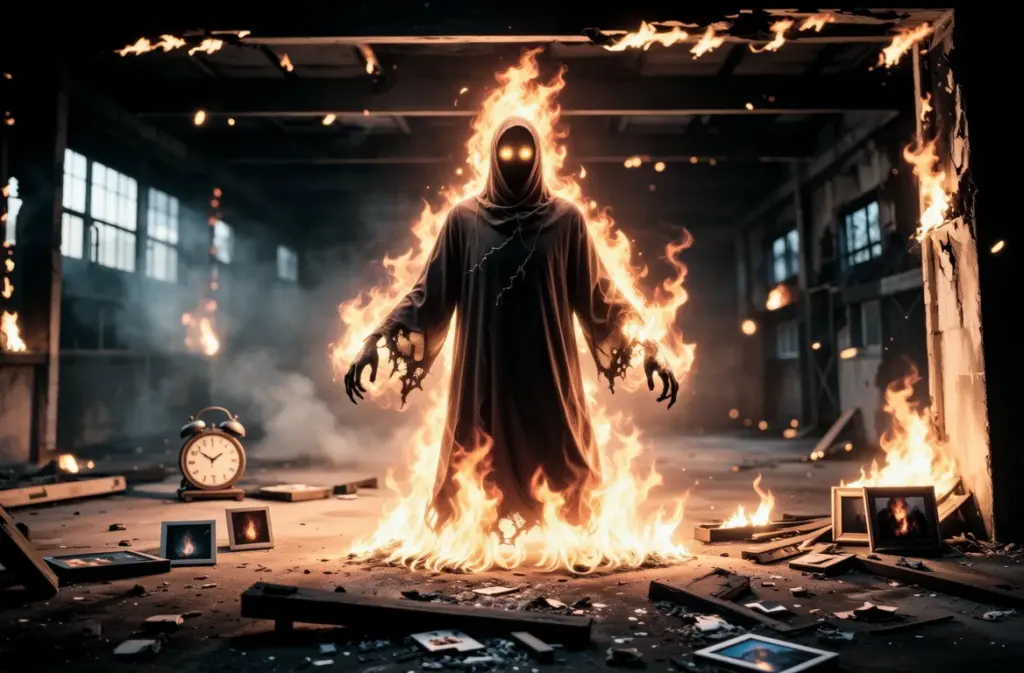
The Fire Ghost, known as Huǒ Guǐ (火鬼) in Chinese folklore, is the vengeful spirit of a person who died in a fire, trapped between the living and the dead. Also referred to as the Flame Wraith or Burning Soul, this entity lingers in places where it perished, often returning to sites of past infernos. Unlike other restless spirits, the Huǒ Guǐ carries an intense energy tied to its violent end, making it one of the most feared supernatural fire entities in Chinese spiritual belief.
Traditionally, the fire ghost folklore warns that these spirits may haunt homes, forests, or villages once consumed by fire, seeking either peace or vengeance. Their presence is often marked by unexplained heat, flickering lights, and the scent of smoke—hallmarks of a lingering fire spirit unwilling to move on.
Information:
- Name: Fire Ghost / Huǒ Guǐ (火鬼)
- Gender: Varies based on individual cases; no fixed gender
- Age: approximately 200–300 years
- Abilities: Manifesting heat, creating phantom flames, inducing nightmares, causing sudden combustion
- Interests: Repeating their final moments, appearing during anniversaries of their deaths, warning or harming trespassers near burned ruins
Origin:
The origins of Huǒ Guǐ trace back to ancient Chinese beliefs about improper death and the soul’s inability to rest. In traditional Taoist and Buddhist cosmology, those who die violently—especially in fire—are believed to suffer a disrupted journey to the afterlife. This disruption traps them in the physical world, especially at the site of their demise.
One well-known tale comes from 17th-century Jiangsu Province, where a family perished in a house fire caused by a lightning strike. Locals claimed that for years afterward, phantom flames appeared every summer on the anniversary of the tragedy. Witnesses described hearing screams and seeing a shadowy figure outlined in smoke—an early account of a haunted burned house attributed to a spirit of fire death.
Another version involves a betrayed wife who was locked inside her home during a fire set by her jealous husband. Her anguished cries and the unbearable heat were said to linger long after the ashes settled, giving rise to fire ghost myth narratives across rural China.
Characteristics:
A Fire Ghost (Huǒ Guǐ) typically appears as a shadowy silhouette surrounded by embers or smoke, sometimes with glowing eyes or charred skin. Unlike typical ghosts, which are cold and ethereal, the burning soul radiates heat, often raising temperatures in rooms they haunt. Some witnesses describe flickering flames following them or smoke without fire emanating from their forms.
These lingering fire spirits are often emotionally unstable, reliving the trauma of their fiery deaths. They may appear in mirrors or reflections, a trait shared with other powerful vengeful spirits in East Asian mythology. In extreme cases, Huǒ Guǐ are said to cause spontaneous fires, reigniting old fears and traumas tied to their deaths.
Their behavior is unpredictable—some are merely mournful, while others seek retribution against those connected to their demise or anyone disturbing the place where they died.
Cultural Significance:
The Fire Ghost (Huǒ Guǐ) holds significant cultural weight in Chinese spiritual traditions, serving as both a cautionary tale and a symbol of unresolved grief. These spirits frequently appear in regional ghost stories, folk operas, and modern horror films such as The Burning Shadow (2019), where ancestral guilt and forgotten tragedies come alive through flame-bound phantoms.
In rural areas, Taoist priests are often called upon to perform exorcisms at locations suspected of being haunted by spirits of fire death. Rituals include burning protective incense, scattering salt, and offering prayers to guide the soul into peace. These practices reflect deep-seated beliefs about the importance of honoring the dead and maintaining harmony between the living and the departed.
The fire ghost folklore also serves as a metaphor for emotional suppression and unresolved trauma, reinforcing the idea that violence and betrayal leave lasting scars—not just in life, but beyond it.
